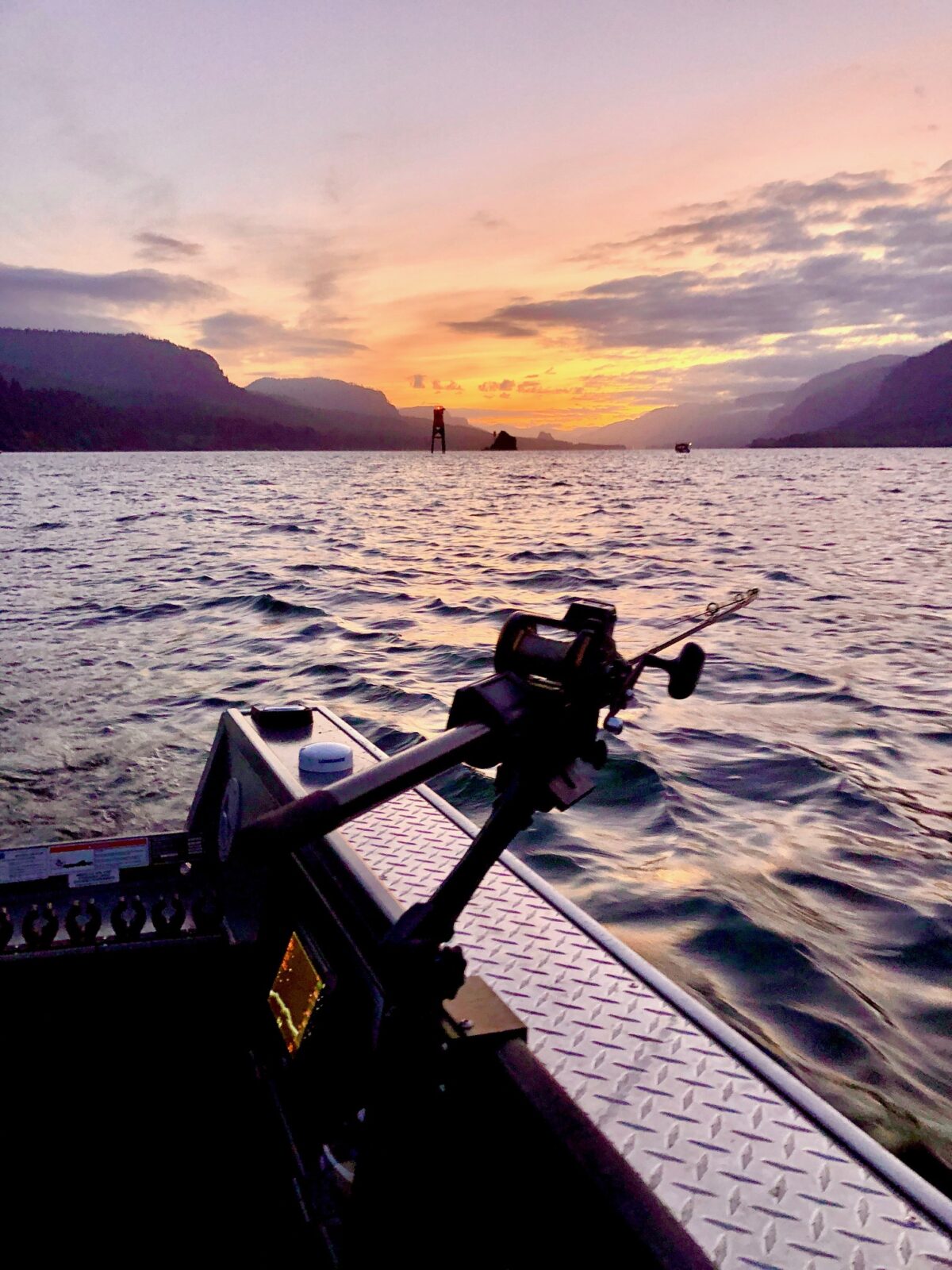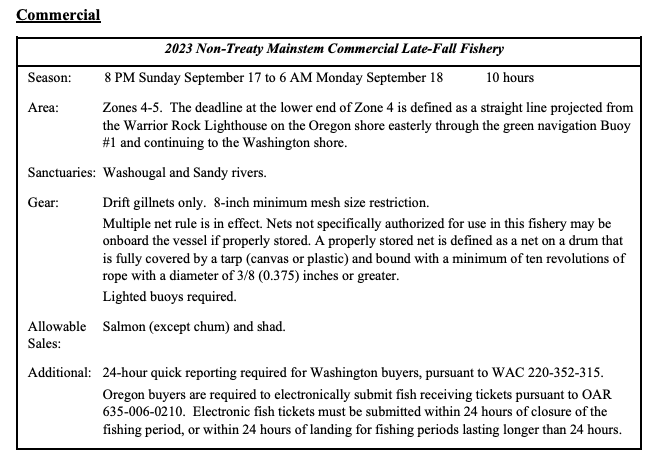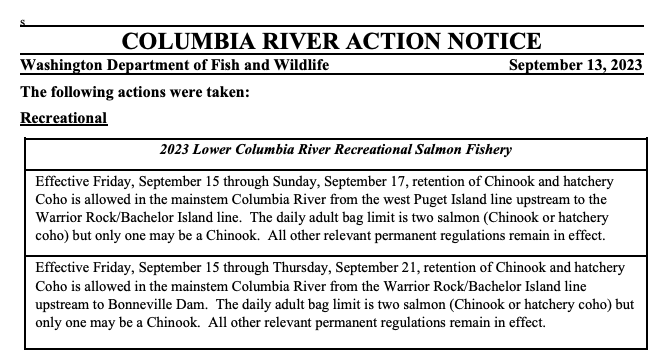
Salmon Season Reopened, Extended On More Of Lower Columbia; Comm Fireworks
Columbia fishery managers this afternoon extended recreational salmon season from Warrior Rock to Bonneville Dam through September 21 and OKed a three-day reopener from Puget Island up to the rock starting September 15.

Daily limit both areas is two salmon but only one Chinook.
ODFW and WDFW managers indicated they’ll be monitoring the fishery to see if more sport opportunity is available. Run forecasts for three fall Chinook stocks were upgraded earlier this week.
That was the easy part; the tough part saw ODFW and WDFW slip well out of concurrency on nontribal commercial fisheries
In a staggering disagreement over the jointly managed river, they could only agree to open one of two proposed 10-hour gillnetting periods in what are called Zones 4 and 5, the Columbia from Warrior Rock to Bonneville Dam.
Washington had balked at doing both, citing a 2022 legislative budget proviso, an unusual statement from WDFW Director Kelly Susewind that was sent out this morning ahead of the meeting, and not enough tule Chinook impacts available in its thinking, and that ultimately led Oregon to strike out on its own and open one in its side of the Columbia later next week.
“If this was viewed as a conservation concern, of exceeding ESA impacts, I think Oregon would be supportive of Washington, but it is not about that,” said ODFW’s Tucker Jones, who represents agency Director Curt Melcher at the Columbia River Compact. “Oregon views this as Washington leaving the confines of the Compact and concurrent management that has existed for a long time.”
Pointing to preseason fishery setting earlier this year, Jones added, “There was a process and a plan.”

WDFW’s Dr. Charlene Hurst, who represents Susewind, summarized his statement, which said in full, “In 2022, the Washington State Legislature approved a commercial license reduction program that saw the number of commercial Columbia River fishing licenses reduced from 240 to 67. The Legislature directed that any impacts to wild fish and Endangered Species Act-listed fish resulting from the retired licenses in the license reduction program should be reserved for conservation by allowing those fish to pass upstream.
“We are committed to meeting the Legislature’s direction to reserve impacts to fish as described in the 2022 budget proviso. We intend to implement this during this fall’s Zones 4 and 5 commercial gillnet fishery on the Columbia River. If we determine that we can achieve the reserved impacts and promulgate an additional fishery, the Department is prepared to support an opening of the commercial fishery. However, if we determine that there are insufficient impacts remaining to both reserve impacts and consider additional fishing period(s), Washington will not consider additional commercial gillnetting period(s) on the Washington side of the river later in September.”
“Though this decision would bring us out of alignment with Oregon on this issue, this does not represent a ‘new normal’ in fishery management on the Columbia. We have enjoyed a productive, collaborative relationship with the varied Columbia River interests for years, and I fully expect that to continue in the future. We will continue working to develop creative solutions to potential conflicts, and I hope we will continue to see concurrent regulations on the river in our future fisheries.”
Hurst focused on this year’s most constraining fall Chinook stock, lower river tules, and while today’s fact sheet stated there was .91 percent impact available for what are designated late fall nontribal commercial fisheries, under Washington’s thinking, there was actually only .64 percent impact available, not enough for the two proposed fishing periods, which would have sucked up an estimated .49 and .41 percent each, just under the limit.
She suggested Columbia commercial fishermen express their opinions during public comment on which of the two proposed openers they’d like to fish, Sunday evening or Tuesday evening.
The netters didn’t budge. They didn’t want one or the other; they wanted both.
“We intend to have our guys fish those days,” stated Jim Wells of Salmon for All.
Others called the Washington budget proviso “expired” and said it had been sprung on the compact call.
But speaking in defense of the legislative directive to WDFW and Susewind’s “resolve” around enforcing the buyback’s conservation components, Nello Picinich of Coastal Conservation Association of Washington said it had been a “$14.5 million investment” by state taxpayers.
The showdown was presaged in early August when Susewind mentioned to the Washington Fish and Wildlife Commission that Washington would be reserving impacts for conservation in the late fall fishery. At the time, two WDFW staffers did not respond to this reporter’s question about the statement.
But as a religious follower of the Columbia River Compact, this to me is a huge deal. Sure, Jones and Hurst (and Bill Tweit before her) have had disagreements, but those have been relatively small. The closest comparison is when WDFW balked at a June keeper sturgeon opener, followed later that year by ODFW demurring on a fall one, and so in the end nothing was opened for retention.
But ODFW going it alone with a commercial fishery on the otherwise jointly managed river is mind-blowing.
Jones asked longtime Oregon staffer Jeff Whisler about it, and Whisler replied, “I haven’t contemplated it too much over the years,” and said he couldn’t know what sort of effort it would generate or what sort of stock composition it might catch.
Even so, Jones said it was “exceedingly unlikely” that an Oregon fishery would exceed tule impact allowances.
As he rattled off the parameters of next Tuesday’s commercial opener on the south side of the big river, he called today “an unfortunate ending place that we couldn’t find concurrency.”
Jones said he really valued the conservation benefit of recreational fisheries removing hatchery salmon that might otherwise stray onto the spawning grounds, and he extolled commercial fisheries connecting nonfishermen to the resource.
Today’s compact call was also notable because of an unusually long statement from the National Marine Fisheries Service, which said that Washington’s move to unilaterally reserve salmon for conservation “appears like a departure from the plan agreed to” earlier this year.
As it stands, the sport reopener below Warrior Rock and extension above it are expected to yield a catch of 7,400 Chinook.

